Sasha loved the tough and versatile pothos plant. She was a keen gardener, always looking to give her houseplants the best care. One day, she looked at her pothos and wondered, “How much light does this plant need to grow well?”
Pothos plants, also called “devil’s ivy,” can grow in many lighting conditions. But, the light they get affects their growth, color, and health. Knowing about the pothos light needs is key to helping them flourish.
Key Takeaways
- Pothos plants do best in bright, indirect sunlight, needing about 9 hours of light daily.
- Variegated pothos types need more light to keep their colors and patterns bright.
- Even though pothos can live in low light, it grows slower and might lose some color.
- Artificial lights like fluorescent or grow lights work well for indoor pothos plants.
- It’s important to keep pothos away from direct sunlight, as it can burn the leaves and dry out the plant.
Introduction to Pothos Plants
The Resilient and Versatile Houseplant
Pothos plants are a top pick for indoor gardeners. They are dependable, easy to care for, and can grow well in many conditions. These lovely pothos plants are known for being tough and versatile. They are great for adding greenery to homes and offices.
Pothos can grow as vines or be pruned to stay bushy. Their lush, green leaves make them perfect for hanging baskets, shelves, and more.
Pothos as houseplants can live five to 10 years with the right care. They can adapt to different conditions and grow well in well-draining soil or aroid mix. They do best in bright, indirect light indoors.
- Pothos plants grow 12 to 18 inches long each month, showing how fast they grow.
- They are hardy in zones 10–12 (USDA) and like temperatures above 50°F. They do best in temperatures between 65°F and 75°F.
- Feeding them balanced houseplant fertilizer once a month in spring and summer helps them thrive.
Versatile pothos plants can handle low light or even do well under fluorescent lights. This makes them ideal for offices and dimly lit spots. Their ability to adjust to different environments and need little care makes them a favorite among indoor gardeners.
“Pothos plants are a go-to choice for adding greenery to homes and offices due to their resilience and versatility.”
Pothos Light Requirements
Pothos plants are known for their ability to thrive in many light conditions. They do best in moderate light conditions. They can handle bright, indirect light to low light levels.
Understanding the Optimal Light Conditions
The amount of light a pothos plant gets affects its look and growth. Too much direct sunlight can burn the leaves and make them turn pale yellow. On the other hand, not enough light can make the leaves fade and the plant grow slowly. Finding the right balance is important for a healthy pothos plant.
Pothos plants are flexible and can do well under artificial lights like fluorescent or grow lights. They just need some darkness each day. The goal is to meet the pothos light needs with a mix of natural and artificial light.
“Pothos plants do best in moderate light conditions, capable of tolerating a range from bright, indirect light to low light levels.”
Knowing the pothos light requirements helps you give your plant the best light. This way, your pothos plant will stay lush and healthy.
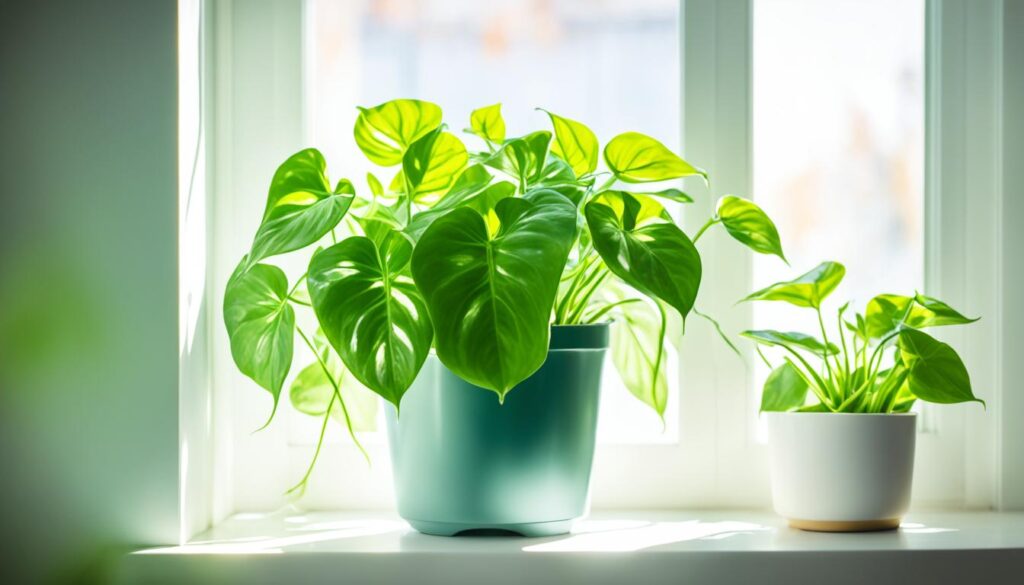
Bright, Indirect Light for Best Growth
Pothos plants do best in bright, indirect. Place them near a window with a sheer curtain or in a spot with filtered sunlight. Don’t put them in direct sunlight, as it can burn and wilt the leaves.
By giving your plant pothos ideal light conditions, it will keep its lush, vibrant look. It will also grow healthily with pothos growth with bright light. The best light intensity for pothos is between 10,000 to 20,000 lux. This is usually found in east-facing or north-facing windows.
- South-facing windows give the most light but can be too hot. North-facing windows might not have enough light for your plant.
- East-facing windows have a good balance of light. They get a few hours of direct light in the morning, perfect for pothos.
- West-facing windows get direct light in the afternoon. Be careful not to let it burn the leaves.
Watch how your plant grows and move it as needed. This way, your pothos will get the pothos bright indirect light it needs for healthy growth.
“Providing the right light conditions through seasons, along with artificial lighting when necessary, can ensure the long-term success of pothos plants.”
Tolerance to Low Light Conditions
Pothos plants love bright, indirect light but can also handle pothos low light tolerance. They’re perfect for homes and offices with less light. Even in low light, pothos grows slowly and its colors might fade. But, it will keep living and looking lush.
Pothos can adapt to shaded areas. They might grow more compact and have smaller leaves. But, they can still do well in pothos growth in low light conditions. This makes pothos a top pick for places with little natural light.
- Pothos plants can tolerate low light conditions, though their growth may slow and variegation may fade.
- They can adapt to shaded areas, though their growth may be more compact with smaller leaves.
- As long as the pothos is not in complete darkness, it can still thrive in low light environments.
“Pothos are surprisingly tolerant of low light conditions, making them a great choice for homes and offices with less natural illumination.”
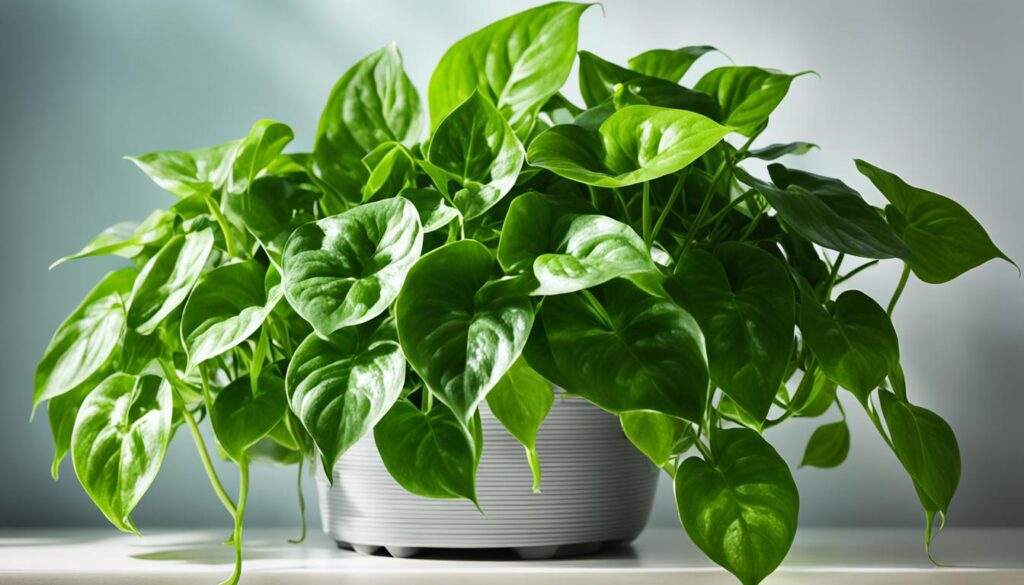
Pothos plants are great at adjusting to pothos in shaded areas. They show how tough and versatile houseplants can be. With the right care, these plants can keep looking good even in places with little natural light. They add greenery and life to any indoor spot.
Artificial Light for Pothos
Pothos plants love bright, indirect sunlight but also do well under artificial lights. This makes them perfect for indoor gardens. Cool white or full-spectrum fluorescent tubes work great for them. You can also use grow lights that fit into standard fluorescent fixtures.
Incandescent lights can be used too, but be careful. They give off a lot of heat, so keep the pothos away from them. Always turn the lights off at night and turn the plant to help it grow evenly.
Fluorescent and Grow Lights for Indoor Cultivation
For indoor pothos, fluorescent lights and grow lights are best. They give a light spectrum that’s close to natural sunlight. This helps your pothos grow and thrive.
- Fluorescent tubes, especially cool white or full-spectrum types, give great light for indoor pothos.
- Horticultural grow lights are also good, fitting right into standard fluorescent setups.
- Avoid incandescent lights because they get too hot and can harm pothos plants.
Don’t forget to give your pothos a break at night by turning off the lights. Also, turn the plant now and then to keep it balanced and healthy.
Do Pothos Need Light?
Pothos plants are known for their toughness and ability to grow in different lighting. But, they can’t live without any light. Pothos do need light to stay healthy and look their best.
The best light for pothos is bright, indirect light. This helps them make food through photosynthesis without burning their leaves in direct sunlight. Pothos can handle a variety of lights, from dim to bright. But, they grow and look their best with the right amount of light.
- Pothos plants can grow about a foot each month in the right light during the growing season.
- They can adjust to low light, but they’ll grow slower and might lose some color in the shade.
- Artificial lights, like fluorescent or grow lights, can help if there’s not enough natural light.
Knowing the pothos light requirements helps you give your pothos the best conditions. With the right light, your pothos will grow well and look beautiful in your home.
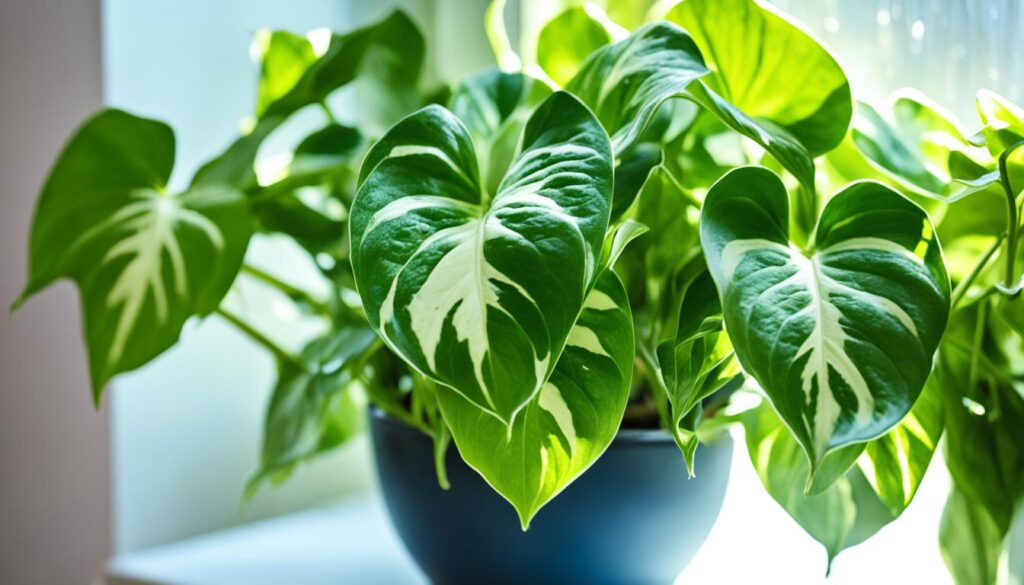
“Pothos plants are one of the most forgiving and adaptable houseplants, but they do need some light to truly flourish.”
Variegated Pothos and Light Needs
Variegated pothos, like the Golden Pothos and Marble Queen Pothos, stand out with their colorful leaves. But, they need more light to keep these colors bright and patterns sharp. This is different from solid green pothos plants.
To keep the unique colors and patterns of pothos, give them bright, indirect light. If they don’t get enough light, the leaves might turn pale green. This happens because the plant uses its energy for photosynthesis instead of keeping its variegation.
Maintaining Vibrant Colors and Patterns
Variegated Neon Pothos likes partial shade, similar to light under a tree or a pergola. It’s important to slowly get it used to outdoor light to avoid problems like leaf drop or yellowing leaves. This process should take about one to two weeks.
For variegated pothos, bright, indirect light is best. This can help them bloom and increase the chance of rare flowers. Using LED grow lights indoors is a good idea. They give a mix of red and blue light, which is important for photosynthesis and keeping the plant healthy.
- Variegated pothos varieties thrive in bright light conditions.
- All-green pothos, such as Jade and Neon Pothos, can tolerate low-light conditions.
- Pothos plants ideally require around 9 hours of bright, indirect sunlight daily to thrive.
With the right amount of light, you can keep a variegated pothos looking its best. This will make your indoor garden bright and eye-catching.
Direct Sunlight and Pothos Plants
Pothos plants are tough and can handle different light levels, but they don’t love direct sunlight. Too much sun can hurt their beautiful leaves. They do well in bright, indirect light instead.
Put your pothos near a window with a curtain or in a bright room. This way, they get enough sunlight without getting burned. If you must put it in direct sunlight, keep it 10 inches from the window.
Direct sunlight can cause problems for your pothos, like:
- Burned, wilted, or yellowing leaves
- Stunted growth and reduced vibrance in the foliage
- Loss of the plant’s signature variegated patterns
To keep your pothos healthy and looking great, find the right balance. Make sure it gets enough bright, indirect light but stays protected from direct pothos direct sunlight. This way, your pothos will stay beautiful and easy to care for.
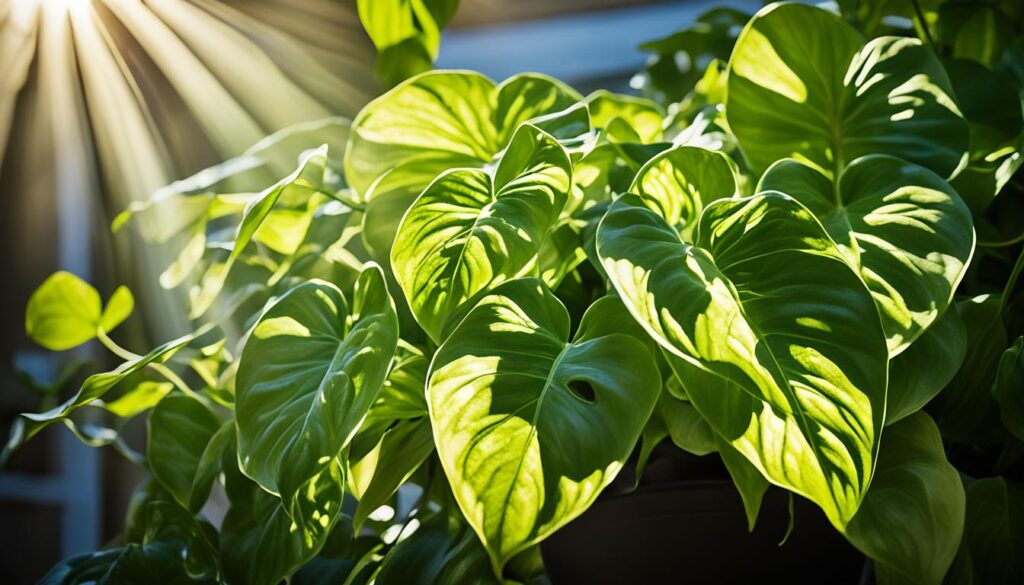
“The key to a happy, healthy pothos is finding the sweet spot between too much and too little light.”
Rotating Your Pothos for Even Growth
To make sure your pothos plant gets even light and looks lush, you should turn it often. This keeps one side from getting too long or weak because of uneven light.
With artificial lights like fluorescent or grow lights, turning the pothos is key. These lights shine in one direction, so some parts of the plant might get more light than others. Turning the plant often makes sure all parts get the same amount of light. This leads to uniform growth all over.
- Turn your pothos plant every 1-2 weeks for even pothos light exposure.
- This easy step keeps even pothos growth and stops one side from getting too long.
- Turning the plant is very important when using pothos plant rotation artificial lighting indoors.
By taking time to turn your pothos, it will do well and look great. This simple habit makes sure your plant gets the optimal light conditions it needs. It helps with both growth and looks.
“Rotating your pothos is a game-changer for maintaining its vibrant, well-rounded appearance.”
Light and Pothos Trailing Habits
The amount of light a pothos plant gets affects its trailing growth and vining habits. In bright, indirect light, pothos grow long, lush vines. These vines can cascade beautifully from shelves or hanging baskets.
In low light, pothos may not grow as tall. It will look more bushy instead. To make your pothos trail, give it bright, indirect light. This helps it grow long, trailing vines.
Encouraging Lush, Trailing Vines
To help your pothos grow long and trail, follow these tips:
- Put the pothos in a spot with bright, indirect sunlight for a few hours a day.
- Avoid direct sunlight to prevent leaf burn and discoloration.
- Use a sheer curtain or keep the plant a few feet from a sunny window to soften the light.
- Consider using a full-spectrum LED grow light in darker months or low-light areas.
- Prune the plant regularly to keep it trailing and encourage new growth.
With the right light conditions, you can enjoy the lush, trailing vines of this versatile houseplant.
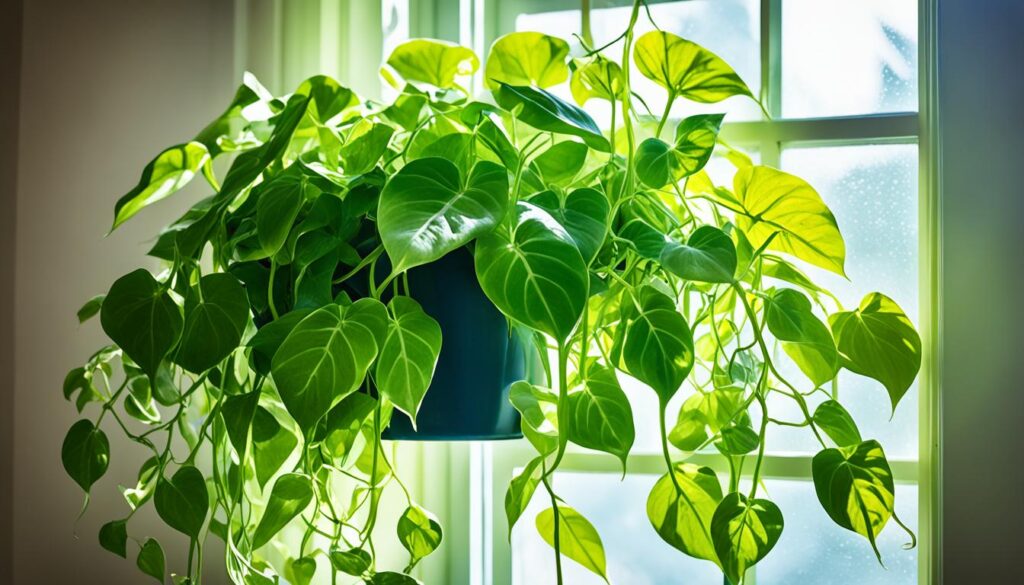
“Pothos plants have a vining, trailing habit, with stems growing to 6-10 feet long indoors and as long as 30-50 feet in their native habitat.”
Pothos Light Requirements in Different Seasons
Pothos plants are known for being tough and flexible. They need different amounts of light throughout the year. In spring and summer, when they grow the most, pothos plants do best in bright, indirect light. This kind of light keeps their leaves colorful and helps them grow strong.
But when the days get shorter, pothos can handle less light without getting stressed. In winter, when they grow less, they can even live in places with less light. This makes them perfect for indoor areas with little sunlight.
To keep your pothos happy all year, watch where you put it and adjust the light as needed. Knowing the pothos light needs by season and their pothos seasonal light requirements helps you create the best home for your plant.
Adapting Pothos to Changing Light Conditions
As seasons change, pay close attention to your pothos’s pothos light conditions. Here are some tips to help your pothos adjust to changing light levels:
- In spring and summer, put your pothos in a spot with bright, indirect light for the best growth and color.
- When days get shorter in fall and winter, move your pothos to a spot with less light to avoid stress and stretched growth.
- Keep an eye on your pothos and move it around as needed to make sure it gets the right amount of light in each season.
By understanding and meeting your pothos’s seasonal light requirements, you can keep your plant healthy and looking great all year, no matter the season.
Pothos Light Troubleshooting
Getting the right amount of light is key for a healthy pothos plant. Sometimes, even the best plant owners face light issues. Knowing how to fix these problems helps your plant get the light it needs.
Addressing Common Light-Related Issues
If your pothos plant looks off, it might have a light problem. Here are some common issues:
- Leaves turning pale or yellow: This could be a sign of too much direct sunlight, which can cause the plant’s foliage to bleach or scorch.
- Loss of variegation or smaller leaves: Inadequate light can cause the plant to lose its vibrant, variegated patterns and produce smaller leaves as it struggles to photosynthesize.
- Slow growth or a leggy appearance: Insufficient light can lead to stunted growth and a stretched, lanky appearance as the plant attempts to reach for more light.
To fix these problems, try moving the pothos to a brighter spot. You can also use artificial lighting if needed.
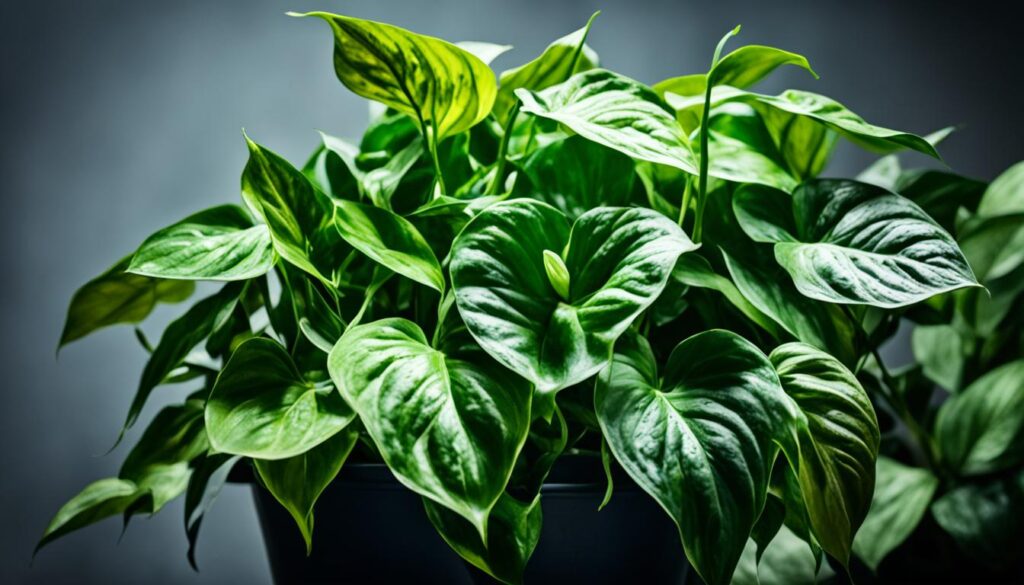
Watch your pothos closely and adjust the light as needed. This way, you can solve any pothos light problems and keep your plant healthy. A healthy pothos should have bright, lush leaves and grow well. So, pay attention to any pothos light issues quickly.
Conclusion
Pothos plants are very adaptable, but knowing the best pothos light conditions is crucial for their health. They love bright, indirect light, which keeps their leaves lush and colorful. Even though they can survive in low light and artificial light, they do best with the right amount of pothos light needs.
To make sure your Pothos plants do well, think about their light needs and adjust as needed. With the right pothos light requirements, they can grow and add beauty to your home or office. These plants are easy to care for and can make any space look elegant.
It’s important to understand the pothos light conditions to keep your Pothos plants healthy and thriving. By learning how to manage their light, you can enjoy these beautiful and easy-to-care-for plants for many years.



Thank you for your sharing. I am worried that I lack creative ideas. It is your article that makes me full of hope. Thank you. But, I have a question, can you help me?